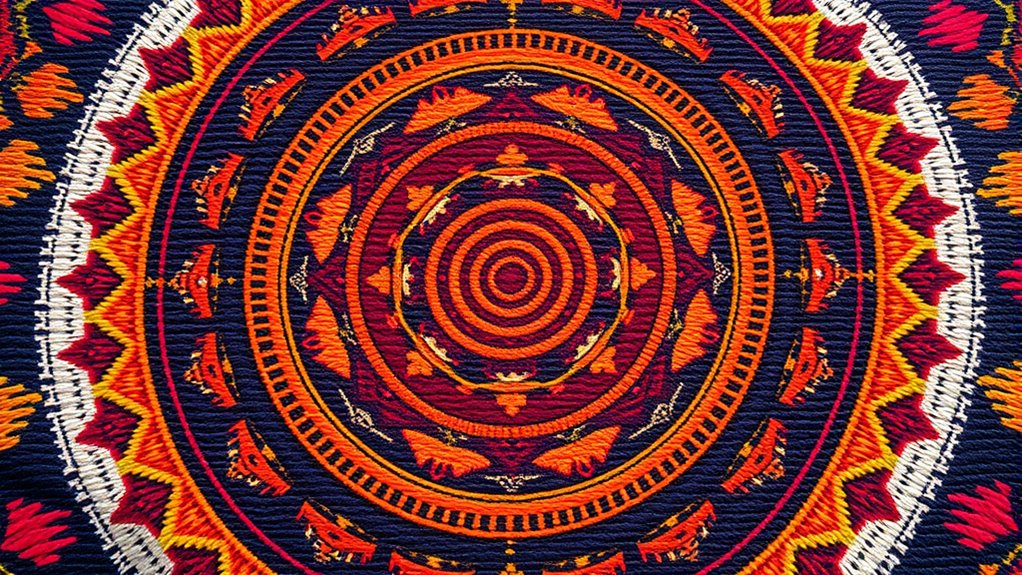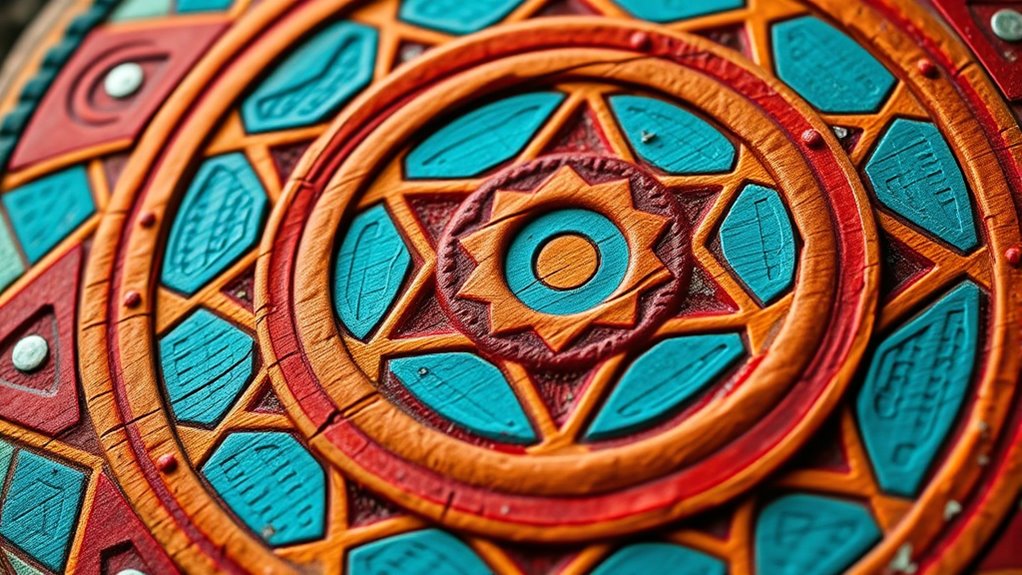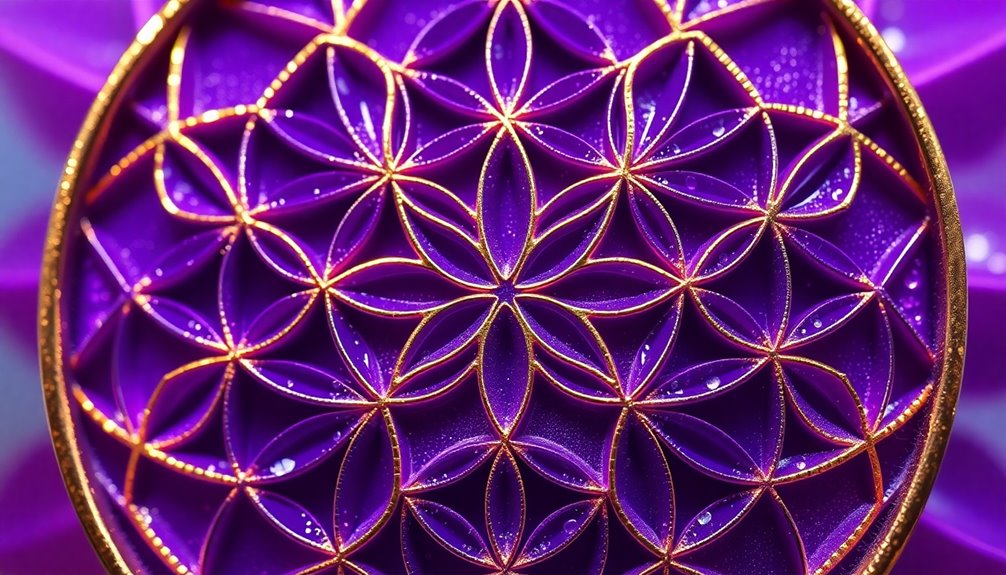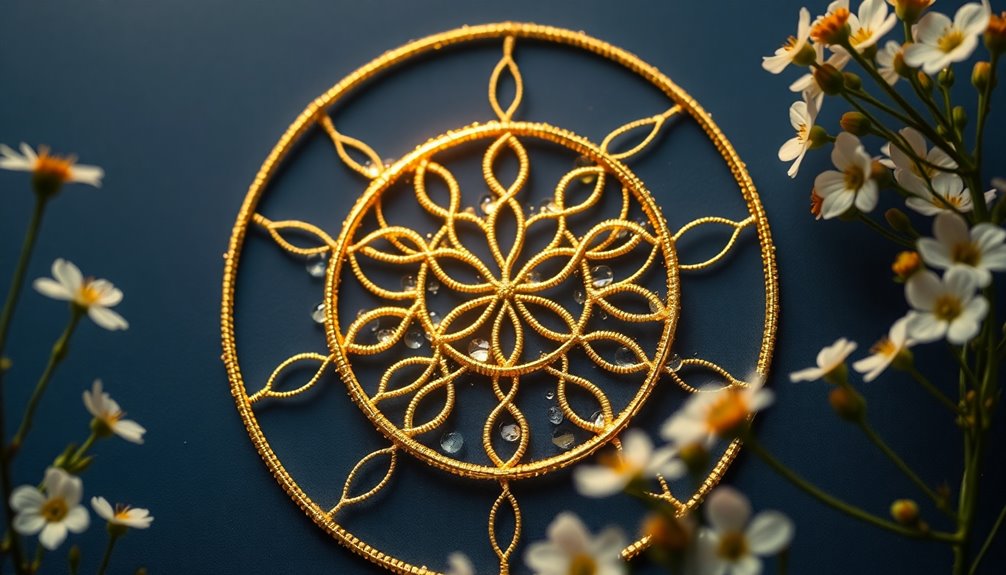Sacred geometry in indigenous American symbolism involves intricate patterns like circles, spirals, and radiating lines that reflect the universe’s divine order. You’ll notice these designs in art, textiles, and sacred sites, serving as visual codes that connect physical and spiritual worlds. They symbolize harmony, balance, and cosmic cycles, often embodying spiritual beliefs and stories of creation. Exploring these patterns reveals a deeper understanding of how communities express their sacred cosmologies—keep exploring to discover more.
Key Takeaways
- Indigenous American art and sacred sites incorporate geometric patterns like circles and spirals, representing cosmological concepts.
- These patterns encode origins of the universe, cycles of nature, and spiritual journeys through sacred geometry.
- Geometric arrangements serve as visual language connecting physical and spiritual worlds, conveying cosmological beliefs.
- Symmetrical designs symbolize harmony, balance, and opposing forces, reflecting the interconnectedness of all life.
- Sacred geometry in Indigenous symbolism embodies spiritual truths, divine order, and cultural stories of creation and harmony.

Have you ever wondered how Indigenous American cultures use geometric patterns to convey spiritual beliefs? These cultures often embed complex designs within their art, textiles, and sacred sites, reflecting a deep understanding of cosmological patterns. These patterns aren’t random; they serve as visual representations of the universe’s structure and the interconnectedness of all life. When you observe these motifs, you’re witnessing more than decoration—you’re seeing a form of spiritual symmetry that embodies their worldview. Indigenous artists and spiritual leaders use these geometric arrangements to communicate stories of creation, harmony, and the divine order that governs existence.
Cosmological patterns are fundamental to this visual language. They encode ideas about the universe’s origins, the cycles of nature, and the spiritual realms that exist beyond everyday perception. For example, many Indigenous symbols feature concentric circles, spirals, or radiating lines that symbolize the cosmos’s eternal cycle or the journey of the soul. These patterns serve as a map of spiritual understanding, guiding practitioners in their spiritual practices and rituals. They’re not just aesthetic choices; they’re sacred codes rooted in sacred geometry that connect the physical world with spiritual dimensions. Understanding the significance of geometric patterns enhances our appreciation of their cultural and spiritual meaning.
Spiritual symmetry plays a vital role in how these patterns are crafted and interpreted. Symmetry in Indigenous art isn’t merely for visual balance; it represents harmony and balance within the universe. When you see symmetrical arrangements in their carvings or beadwork, recognize that they symbolize the balance between opposing forces—light and dark, life and death, chaos and order. This harmony reflects their core belief that everything in existence is interconnected and part of a greater divine plan. The symmetry underscores the idea that spiritual truth is reflected in nature’s order, which Indigenous cultures honor through their geometric designs.
Frequently Asked Questions
How Does Sacred Geometry Influence Modern Indigenous Art?
Sacred geometry influences your modern indigenous art by shaping its symbolic meanings and aesthetic patterns. You see these geometric designs incorporated into contemporary pieces, blending traditional symbolism with new expressions. This fusion allows you to honor cultural roots while embracing modern adaptations. Sacred geometry serves as a powerful visual language, connecting past and present, and enriching your artwork with deeper spiritual significance and universal harmony.
Are Specific Geometric Patterns Linked to Particular Tribes?
Yes, specific geometric motifs are linked to particular tribes, serving as unique tribal symbols. You’ll notice these patterns in their art, textiles, and carvings, often representing spiritual beliefs or cultural stories. These motifs act as visual identifiers, connecting tribe members and honoring traditions. By recognizing these geometric patterns, you gain insight into each tribe’s identity and history, appreciating how sacred geometry shapes their cultural expressions.
What Tools Were Used to Create Sacred Geometric Designs Historically?
You would likely use traditional carving tools like stone or bone chisels to create sacred geometric designs on surfaces such as wood or stone. For coloring, natural pigments derived from minerals, plants, and charcoal were applied with brushes or fingers. These tools allowed you to meticulously carve and paint intricate patterns, preserving cultural symbolism and spiritual significance in your artwork. The combination of these methods helped maintain the authenticity of your sacred geometric designs.
How Is Sacred Geometry Connected to Indigenous Spiritual Practices?
You see, sacred geometry connects deeply with indigenous spiritual practices through cosmic alignment and ritual symbolism. It guides you to understand the universe’s divine order, reflecting sacred patterns that symbolize life’s interconnectedness. During rituals, these geometric designs serve as metaphors for spiritual journeys, helping you align with cosmic energies. This sacred language reinforces cultural identity, spiritual insight, and a profound connection to the cosmos, making it essential in indigenous traditions.
Can Sacred Geometric Principles Be Found in Indigenous Architecture Worldwide?
Yes, you can find sacred geometric principles in indigenous architecture worldwide. These structures often reflect cosmological patterns and geometric symbolism, embodying beliefs about the universe and spiritual connections. For example, you might notice precise ratios, symmetry, or recurring patterns that symbolize harmony and balance. These geometric designs serve as visual expressions of cultural identities and spiritual principles, linking architecture to the cosmos and reinforcing cultural stories across different indigenous traditions.
Conclusion
In embracing the intricate influence of sacred geometry, you discover a divine design deeply embedded in indigenous symbols. These sacred shapes serve as spiritual signposts, showcasing a shared sacredness that spans cultures and continents. By understanding these symbols, you not only uncover universal truths but also unite with the timeless tapestry of tradition. Let these layered layouts lead you into a luminous link, illuminating the lasting legacy of indigenous wisdom woven through the wondrous world of sacred geometry.











